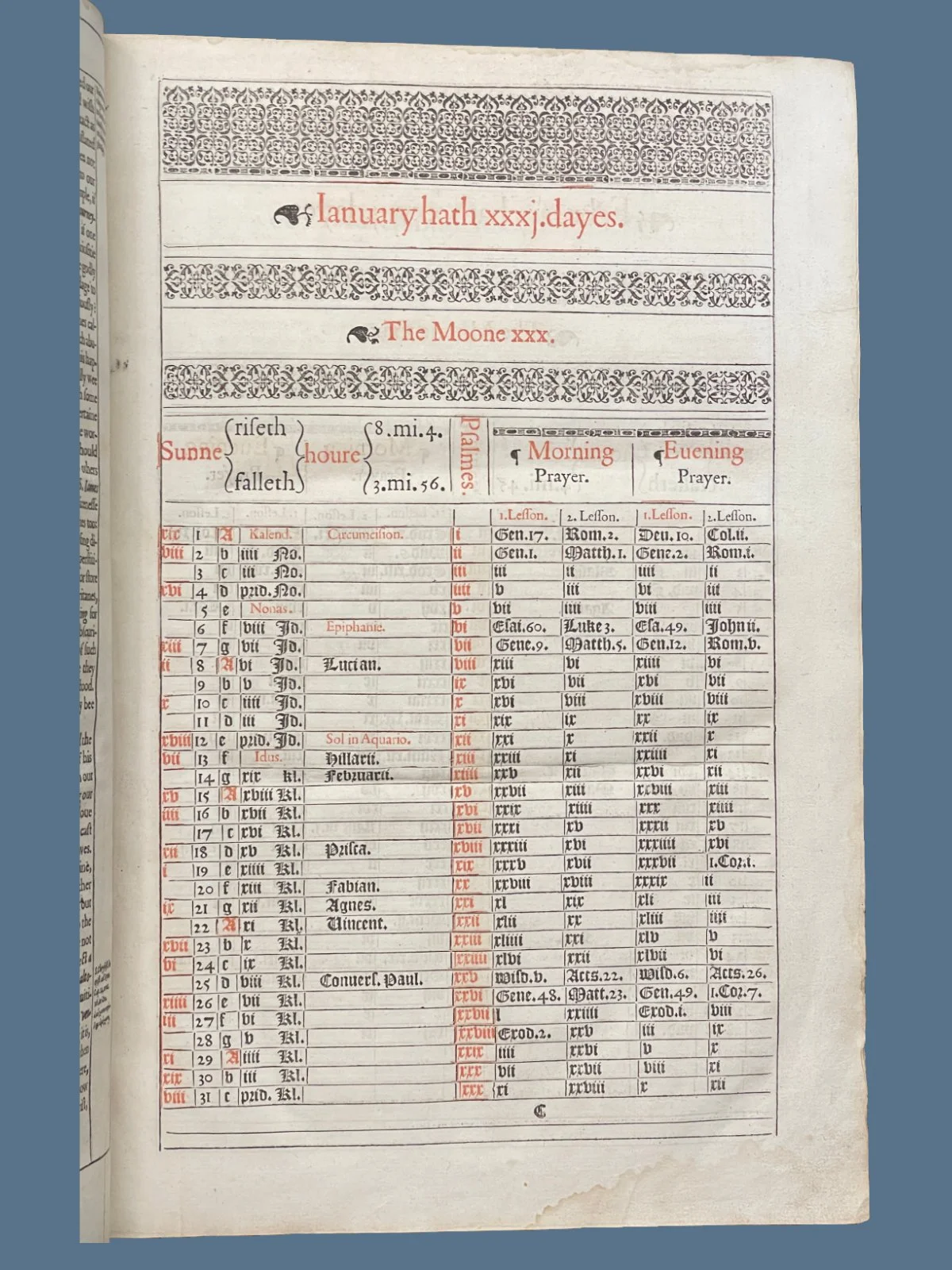The Holy Bible, Conteyning the Old Testament and the New. Newly Translated Out of the Originall Tongues: And with the former translations diligently compared and revised, by his Maiesties Speciall Comandement…
Summary
The Great She Bible – a very clean example of the 59-line folio with the misprint of “Judas” instead of “Jesus”. Unlike the 72-line folio edition also printed in 1613, this is the more valuable, desirable, and scarce second of the five folios printed with 59 lines to the full column.
Description
General title page (1613) with woodcut border and the twelve tribes of Israel on the left, the twelve disciples on the right. The four evangelists with their gospel symbols around the letterpress with the Tetragrammaton, the dove, and the slain Lamb at the center. Calendar printed in red and black, tailpieces accented with red wash. Text in large two column black letter type with 59 lines to the full column and within a ruled border. With the reading “and she went into the citie” in Ruth 3:15. Similar New Testament title page (1611). Matthew 26:36 with “Judas” instead of “Jesus” and the list of books contains “1 Corinthians” and “2 Corinthians” in the place of “1 Chronicles” and “2 Chronicles” with three lines printed in red. This copy includes the corrective slip with "Jesus" that was pasted over "Judas" initially. Woodcut initials, head- and tailpieces throughout.
Collation
A-B^4, C^6, D^4 [prelims], A-C^6 [Genealogies without map], A-Z^6, Aa-Zz^6, Aaa-Zzz^6, Aaaa-Zzzz^6, Aaaaa-Ccccc^6 [Old Testament and Apocrypha]; A-Z^6, Aa^6 (-Aa6) [New Testament]. Lacks Revelation 20:13 – 22:21.
Binding
Contemporary gilt-paneled black calf. Boards with corner fleurons and floral designs. Spine with six raised bands and elaborate tooling to compartments. Inner dentelles. All edges gilt. Marbled endpapers. Joints worn but firm. Corners bumped, spine extremities worn.
Condition
Generally a bright and clean copy; general title mounted to stub; two leaves with small marginal tears; I-K light stain, mostly to gutter; seven leaves with lower margin reinforced without loss; P1,2 closed tear into text without loss; Aa5 (final extant leaf in Revelation) stained with edges frayed.
Provenance
Inscribed with Wickham family tree 1565-1599 and again 1801-1874 by James Anthony Wickham. John Wickham (1717-1788) of Longashton; gifted to his nephew James Anthony Wickham (1768-1854); bequeathed to James Whalley Dawe Thomas Wickham; Reverend Edmund Dawe Wickham (1810-1894), by descent to James Wickham (Nov 1965).
Note
A royal monument of English literature—and arguably the greatest work of English prose ever written—the King James Bible stands unmatched in influence and beauty. These tall folio copies were designed for use in large pulpits, with five folio editions issued in 1611, 1613, 1617, 1634, and 1639/40. The folios contain interchangeable sheets (each beginning and ending with the same letters).
In addition to the standard 59-line folio, a smaller 72-line folio was also printed in 1613, though the 59-line version is more scarce and more valuable. Francis Fry referred to the She Bible as the “first edition, second issue,” though it is more accurately described as the second edition.
It is probable that most of this edition was printed in 1611, after completion of the He Bible. A fire is believed to have broken out in Robert Barker’s print house, destroying the original engraved general title page along with many sheets from the She Bible. Barker subsequently sold incomplete copies, and as differing sheets became available, no two copies were assembled from the exact same set.
Arguably the most important book ever published in English, its influence is beyond measure. As historian G. M. Trevelyan observed:
“For every Englishman who had read Sidney or Spenser, or had seen Shakespeare acted at the Globe, there were hundreds who had read or heard the Bible with close attention as the words of God. The effect of the continual domestic study of the book upon the national character, imagination, and intelligence for nearly three centuries to come, was greater than that of any literary movement in our annals, or any religious movement since the coming of St. Augustine.”
Thomas Babington Macaulay added:
“If everything else in our language should perish, [the King James Bible] would alone suffice to show the whole extent of its beauty and power.”
References
Herbert 319; STC 2224; ESTC S123049; PMM 114.




























